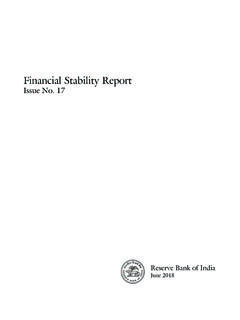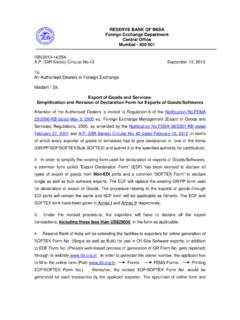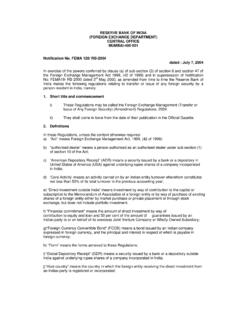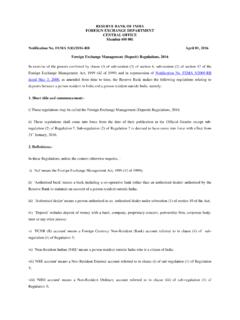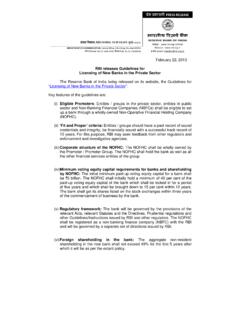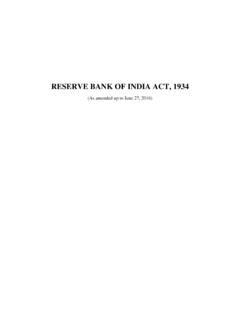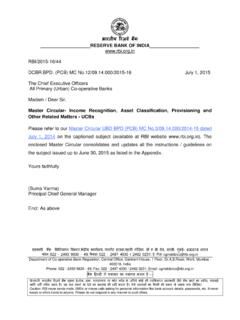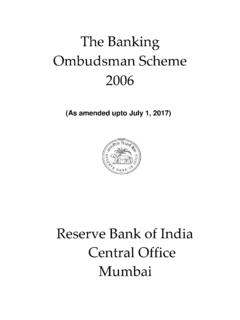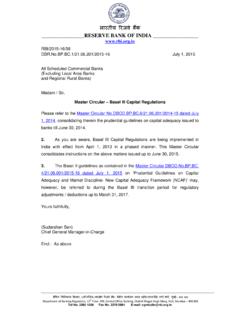Transcription of Reserve Bank of India: Functions and Working
1 Reserve Bank of India: Functions and Working Reserve BANK OF Reserve Bank of India, the nation s central bank, began operations on April 01, 1935. It was established with the objective of ensuring monetary stability and operating the currency and credit system of the country to its advantage. Its Functions comprise monetary management, foreign exchange and reserves management, government debt management, financial regulation and supervision, apart from currency management and acting as banker to the banks and to the Government. In addition, from the beginning, the Reserve Bank has played an active developmental role, particularly for the agriculture and rural sectors.
2 Over the years, these Functions have evolved in tandem with national and global developmentsThis book aims to demystify the central bank by providing a simple account of the Reserve Bank s operations and the multidisciplinary nature of its Functions . The Bank today focuses, among other things, on maintaining price and financial stability; ensuring credit flow to productive sectors of the economy; managing supply of good currency notes within the country; and supervising and taking a lead in development of financial markets and institutions. The book serves to highlight how the Reserve Bank s decisions touch the daily lives of all Indians and help chart the country s economic and financial hope that readers would find the book , authored by the staff of the Bank, useful in getting a better appreciation of the policies and concerns of the Reserve J.
3 SadakkadullaPrincipalReserve Bank Staff CollegeChennai45 ContentsS. No. Chapters Page Overview 72 Organisation 123 Monetary Management 214 Issuer of Currency 275 Banker and Debt Manager to Government 326 Banker to Banks 357 Financial Regulation and Supervision 388 Foreign Exchange Reserves Management 529 Foreign Exchange Management 5510 Market Operations 6011 Payment and Settlement Systems 6312 Developmental Role 6713 Research and Data Dissemination 7614 How Departments Work 7915 Chronology of Important Events in the History of the Bank 107 Annex - 1 Publications by the Reserve Bank 112 Annex 2 List of Abbreviations 1146 Index on BoxesS.
4 No. Name of the Box Item Page Origins of the Reserve Bank of India 82 Functions of the Reserve Bank 83 Central Office Departments 154 Monetary Policy Transmission 245 Currency Unit and Denomination 286 Banker to Banks 367 Prudential Norms 418 Investment of Reserves 539 Foreign Exchange Reserves Management: The RBI s Approach 5410 Payment and Settlement System: Evolution and Initiatives 6411 Institutions to meet Needs of the Evolving Economy 7312 Improving Banking Services in Comparatively Backward States 747 The origins of the Reserve Bank of India can be traced to 1926, when the Royal Commission on Indian Currency and Finance also known as the Hilton-Young Commission recommended the creation of a central bank for India to separate the control of currency and credit from the Government and to augment banking facilities throughout the country.
5 The Reserve Bank of India Act of 1934 established the Reserve Bank and set in motion a series of actions culminating in the start of operations in 1935. Since then, the Reserve Bank s role and Functions have undergone numerous changes, as the nature of the Indian economy and financial sector changed. Overview18 Starting as a private shareholders bank, the Reserve Bank was nationalised in 1949. It then assumed the responsibility to meet the aspirations of a newly independent country and its people. The Reserve Bank s nationalisation aimed at achieving coordination between the policies of the government and those of the central bank.
6 1926: The Royal Commission on Indian Currency and Finance recommended creation of a central bank for India. 1927: A bill to give effect to the above recommendation was introduced in the Legislative Assembly, but was later withdrawn due to lack of agreement among various sections of people. 1933: The White Paper on Indian Constitutional Reforms recommended the creation of a Reserve Bank. A fresh bill was introduced in the Legislative Assembly. 1934: The Bill was passed and received the Governor General s assent 1935: The Reserve Bank commenced operations as India s central bank on April 1 as a private shareholders bank with a paid up capital of rupees five crore (rupees fifty million).
7 1942: The Reserve Bank ceased to be the currency issuing authority of burma (now Myanmar). 1947: The Reserve Bank stopped acting as banker to the Government of burma . 1948: The Reserve Bank stopped rendering central banking services to Pakistan. 1949: The Government of India nationalised the Reserve Bank under the Reserve Bank (Transfer of Public Ownership) Act, of the Reserve Bank of IndiaThe Functions of the Reserve Bank today can be categorised as follows: Monetary policy Regulation and supervision of the banking and non-banking financial institutions, including credit information companies Regulation of money, forex and government securities markets as also certain financial derivatives Debt and cash management for Central and State Governments Management of foreign exchange reserves Foreign exchange management current and capital account managementFunctions of the Reserve Bank Box 1 Box 29 The Preamble to the Reserve Bank of India Act, 1934 (the Act)
8 , under which it was constituted, specifies its objective as to regulate the issue of Bank notes and the keeping of reserves with a view to securing monetary stability in India and generally to operate the currency and credit system of the country to its advantage . The objectives outlined in the Preamble hold good even after 75 evident from the multifaceted Functions that the Reserve Bank performs today, its role and priorities have, in the span of 75 years, changed in tandem with changing national priorities and global developments. Essentially, the Reserve Bank has demonstrated dynamism and flexibility to meet the requirements of an evolving economy.
9 A core function of the Reserve Bank in the last 75 years has been the formulation and implementation of monetary policy with the objectives of maintaining price stability and ensuring adequate flow of credit to productive sectors of the economy. To these was added, in more recent times, the goal of maintaining financial stability. The objective of maintaining financial stability has spanned its role from external account management to oversight of banks and non-banking financial institutions as also of money, government securities and foreign exchange markets. The Reserve Bank designs and implements the regulatory policy framework for banking and non-banking financial institutions with the aim of providing people access to the banking system, protecting depositors interest, and maintaining the overall health of the financial system.
10 Its function of regulating the commercial banking sector, which emerged with the enactment of the Banking Regulation Act, 1949, has over time, expanded to cover other entities. Thus, amendments to the Banking Regulation Act, 1949 brought cooperative banks and regional rural banks under the Reserve Bank s jurisdiction, while amendments to the Reserve Bank of India Act saw development finance institutions, non-banking financial companies Banker to banks Banker to the Central and State Governments Oversight of the payment and settlement systems Currency management Developmental role Research and statistics Continuity with Change10and primary dealers coming under its regulation, as these entities became important players in the financial system and markets.
